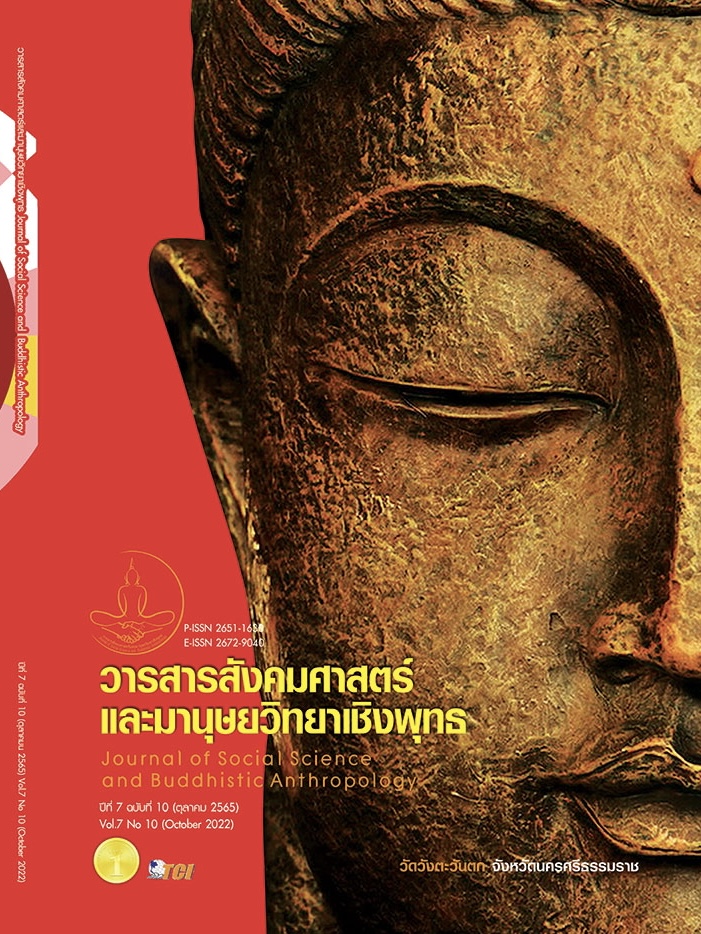MELAYU CULTURAL HERITAGE IS TRANSMITTED THROUGH A CROSS-CULTURAL COMMUNICATION PROCESS USING VIRTUAL INHERITANCE TECHNOLOGY
Keywords:
Melayu Pattani Intellectual Heritance, Cross-Cultural Communication, Immersive TechnologyAbstract
The objectives of this academic paper were to review about the concept and communication theories, cross-cultural communication, and cultural propagation. To apply the aforementioned knowledge in the inheritance of intellectual heritage of Melayu Pattani arts and culture. The results of the body of knowledge review found that Traditional Malay artworks reflect the Melayu culture of Pattani, as well as the cultural and artistic heritage of the Melayu ethnic group that is invaluable to the communities in the southern provinces. And the art that represents these cultures will be transmitted through many forms of art, including painting and architectural works as well as performing arts such as; Rongngeng, Sampeng Ma Yong, from Mayong to Nora, Wayangseum, Likehulu, Krueto, Dara and Banor, which are beautiful and unique, clearly represent the Malayu people. And factors influencing the art of Melayu Pattani in addition to geography and lifestyle factors, life philosophy, Islamic beliefs that have been passed down for a long time are also important factors that determine the pattern of Melayu Pattani art and culture. To preserve and inherit Melayu Pattani arts and culture to remain requires participation from both the government-private sector and from the community itself, such as participating in various art exhibitions held. In addition, people in the community can also carry on the inheritance of arts and culture with the process of spreading culture through the process of cross-cultural communication by producing a variety of video and public relations materials combined with the use of immersive technology and communication technologies.
References
กษมาพร แสงสุระธรรม. (2558). ในนิยาม “ความเป็นไทย” : “ศิลปะจากปัตตานี” ในเวทีการประกวดศิลปกรรมไทย พ.ศ. 2549-2558. วารสารสังคมวิทยามานุษยวิทยา, 34(1), 81-106.
คณะอนุกรรมการและประสานงานวันอนุรักษ์มรดกไทย. (2563). วันอนุรักษ์มรดกไทย. เรียกใช้เมื่อ 22 เมษายน 2564 จาก https://www.m-culture.go.th/ phatthalung/ewt_news.php?nid
คำล่า มุสิกา. (2556). การจัดการมรดกทางวัฒนธรรมของชุมชน กรณีศึกษา: ฟ้อนกลองตุ้มจังหวัดอุบลราชธานี. วารสารวิจัยเพื่อการพัฒนาเชิงพื้นที่ (สกว.), 5(6), 21-37.
เจะอับดุลเลาะ เจ๊ะสอเหาะ. (2561). “ปาตานี อาร์ตสเปซ” รากเหง้าศิลปะมลายู. เรียกใช้เมื่อ 6 มกราคม 2564 จาก https://voicetv.co.th/read/MGHGeb2IM
ฉัตรพงศ์ ชูแสงนิล. (2562). Immersive Technology เทคโนโลยีเสมือนที่จะทำให้เรา “อิน”. เรียกใช้เมื่อ 16 มกราคม 2564 จาก https://www.scimath.org/article-technology/item/10457-immersive-technology
ชญาดา รัตนพันธ์. (2560). วิเคราะห์เปรียบเทียบการแสดงรองเง็งฝั่งตะวันออกกับฝังตะวันตก. วารสารวิทยาลัยนครราชสีมา, 11(1), 71-82.
ณายิบ อาแวบือซา. (2556). สถาปัตยกรรมมลายูในท้องถิ่นสามจังหวัดภาคใต้. ใน การบรรยาย วันที่ 5 มิถุนายน พ.ศ.2556 ห้องประชุมชั้น 2 มูลนิธิเล็ก-ประไพ วิริยะพันธุ์. มูลนิธิเล็ก-ประไพ วิริยะพันธุ์.
นาจิ๊บ บิน ออหมัด. (2559). บรรยายสาธารณะ: สถาปัตยกรรมมลายูในท้องถิ่นสามจังหวัดภาคใต้. เรียกใช้เมื่อ 20 มีนาคม 2564 จาก https://lek-prapai.org/ home/view.php?id=1043
บุญชู บุญลิขิตศิริ. (2561). การออกแบบสื่อความเป็นจริงเสริมหอศิลปะและวัฒนธรรมภาคตะวันออก. วารสารสารสนเทศศาสตร์, 36(3), 19-41.
ปัญญา เทพสิงห์ และเก็ตถวา บุญปราการ. (2559). ภูมิปัญญาท้องถิ่นในวัฒนธรรมชายแดนไทย-มาเลเซีย : กรณีศึกษาชุมชนโล๊ะจูด จังหวัดนราธิวาส. วารสารมหาวิทยาลัยราชภัฏยะลา, 11(1), 19-38.
พัชราภา เอื้ออมรวนิช. (2560). การสื่อสารระหว่างวัฒนธรรม. วารสารวิชาการคณะวิทยาการจัดการ มหาวิทยาลัยราชภัฏมหาสารคาม, 2(3), 97-102.
พัชรีพร วรจักร. (2559). รูปแบบการทำนุบำรุงศิลปวัฒนธรรมของสถาบันอุดมศึกษาในภาคตะวันออกเฉียงเหนือ. ใน ดุษฎีนิพนธ์การศึกษาศาสตรดุษฎีบัณฑิต สาขาวิชาการบริหารการศึกษา คณะศึกษาศาสตร์. มหาวิทยาลัยบูรพา.
พิมพ์มณี ชาติสมบูรณ์. (2562). ปัจจัยที่มีอิทธิพลต่อประสิทธิภาพการสื่อสารข้ามวัฒนธรรมของพนักงานชาวไทยในองค์กรเอกชนต่างชาติที่ใช้ภาษาอังกฤษเป็นสื่อกลางในการสื่อสาร. ใน รายงานการวิจัย. มหาวิทยาลัยรามคำแหง.
ภาสกร ใหลสกุล. (2559). ดื่มด่ำล้ำลึกด้วย Immersive Technology. เรียกใช้เมื่อ 20 กุมภาพันธ์ 2564 จาก https://tednet.wordpress.com/2015/07/31/ดื่มด่ำล้ำลึกด้วย-immersive-technology
มานิตย์ กันทะสัก. (2560). พุทธศิลปกรรมล้านนา: แนวคิด คุณค่า การสร้างสรรค์เพื่อเสริมสร้างจิตวิญญาณและการเรียนรู้ของสังคม. ใน รายงานการวิจัย. มหาวิทยาลัยมหาจุฬาลงกรณ์ราชวิทยาลัย วิทยาลัยสงฆ์เชียงราย.
ราชบัณฑิตยสถาน. (2530). พจนานุกรมฉบับเฉลิมพระเกียรติ. กรุงเทพมหานคร: ไทยวัฒนาพานิช.
สถาบันนาฏดุริยางคศิลป์. (2542). วิพิธทัศนา. กรุงเทพมหานคร: บริษัทเซเว่น พริ้นติ้งกรุ๊ป.
สำนักงานส่งเสริมเศรษฐกิจดิจิทัล. (2563). “ดีป้า” ยกขบวนดิจิทัลสตาร์ทอัพเข้าพบรัฐมนตรีว่าการกระทรวงศึกษาธิการนำเสนอเทคโนโลยีเพื่อการศึกษา ช่วยยกระดับการศึกษาไทยในยุคดิจิทัล. เรียกใช้เมื่อ 20 กันยายน 2564 จาก https://www. depa.or.th/th/article-view/20200220_04
สุนทรียา ไชยปัญหา และอุรารักษ์ ศรีประเสริฐ. (2559). แนวคิด ทฤษฎีวัฒนธรรมการจัดการ : การปรับตัวภายใต้ความแตกต่างทางวัฒนธรรม. วารสารวิชาการ คณะวิทยาการจัดการ มหาวิทยาลัยราชภัฎมหาสารคาม, 1(2), 104-116.
เหมือนพิมพ์ สุวรรณกาศ. (2551). สถาปัตยกรรมมลายูในท้องถิ่นสามจังหวัดชายแดนใต้. เรียกใช้เมื่อ 27 กุมภาพันธ์ 2565 จาก https://lek-prapai.org/home/ view.php?id=150
เอื้องฟ้า ถาวรรักษ์. (2555). การอนุรักษ์ สืบทอดศิลปะการแสดงพื้นบ้านชาวกะเหรี่ยง “รำตง” อำเภอศรีสวัสดิ์ จังหวัดกาญจนบุรี. กาญจนบุรี: สำนักงานวัฒนธรรมจังหวัดกาญจนบุรี.
Barnett, H. G. (1953). The Basis of Cultural Change. New York: McGrawhill.
Berlo, K. (1960). The Process of Communication. New York: Hoit, Rinehart and Winston.
Boas, F. (1970). The social organization and the secret societies of the Kwakiutl Indians/by Franz Boas. New York: Johnson Reprint Corp.
Rogers, E. M. & Shoemaker, F. F. (1971). Communication of Innovations : A Cross Cultural Approach. New York: The Free Press.
Downloads
Published
How to Cite
Issue
Section
License
Copyright (c) 2022 Journal of Social Science and Buddhistic Anthropology

This work is licensed under a Creative Commons Attribution-NonCommercial-NoDerivatives 4.0 International License.








